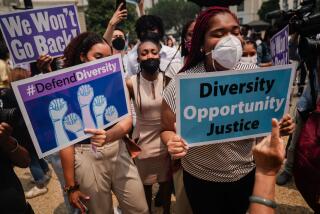Op-Ed: A conservative quandary in affirmative action case Fisher vs. Texas

Abigail Fisher, right, is the plaintiff in a case before the U.S. Supreme Court who is challenging the University of Texas’ consideration of race and ethnicity in admissions.
- Share via
On Wednesday, the Supreme Court will once again consider affirmative action. The question in Fisher vs. Texas is whether the University of Texas may lawfully take into account the race of its applicants alongside other non-academic criteria. Many amicus briefs have been filed in the case by conservative groups siding with the plaintiff and asking the court to end any and all use of race in university admissions across the country. But if the court takes conservative jurisprudence seriously, then Texas, not the plaintiff, should rightly prevail.
As Justice John Paul Stevens put it, there is a significant difference between a “welcome mat” for minorities and a “no trespassing sign.”
Abigail Fisher, a white woman, alleges that she was illegally denied admission by the University of Texas on account of her race. She argues that the Equal Protection Clause of the 14th Amendment prohibits the university from looking at the race of its applicants in any manner, even if the goal is diversity rather than segregation, and even if race plays only a small role in the decision.
There is general agreement among judges and academics that the government may not discriminate against traditionally disadvantaged groups such as racial minorities without the strongest of justifications. There is real debate, however, over whether the government may consider race when trying to remedy our long and sordid history of discrimination or when trying to achieve more diversity.
Conservative justices have consistently argued that the Equal Protection Clause requires all governmental decisions to be made on a “color blind” basis, and that the way to stop racial discrimination is, in Chief Justice John Roberts’ words, to “stop discriminating on the basis of race.” Liberal justices have generally disagreed because, as Justice John Paul Stevens put it, there is a significant difference between a “welcome mat” for minorities and a “no trespassing sign.”
Who’s right? Conservatives normally insist that unelected judges should not overturn laws (like those relating to abortion or gay rights) unless the Constitution’s text or its history is clear. But the Equal Protection Clause does not even mention race. How can self-identifying textualists like Justices Antonin Scalia and Clarence Thomas therefore conclude that the 14th Amendment prohibits the use of any and all racial preferences in university
admissions?
Because the text cannot resolve the issue, conservative justices have looked to Justice John Marshall Harlan’s dissenting opinion in the infamous case Plessy vs. Ferguson, which
upheld separate seating for whites and blacks on public transportation. Harlan argued that “Our Constitution is color-blind, and neither knows nor tolerates classes among its citizens. In respect of civil rights, all citizens are equal before the law.”
Harlan, however, was objecting to formal governmental rules intended to confer second-class citizenship on a distinct group of minority citizens. No reasonable person can believe that the University of Texas, by trying to increase the diversity of its classrooms, is trying to bestow second-class citizenship on anyone or any group. Unlike the state of Louisiana in Plessy, Texas is trying to bring the races together, not keep them apart, and all racial groups are welcome. Currently, the University of Texas is roughly 50% white and 50% people of color.
Conservative justices also usually privilege the original meaning of the constitutional text, giving weight to how lawmakers or the people at the time understood it. At the time the 14th Amendment was adopted, and shortly thereafter, the federal government had in place race-conscious programs to help newly freed slaves and other people of African descent. Any reliance on history in Fisher therefore undercuts the theory that the 14th Amendment was meant to enforce complete color-blindness, and supports the argument that programs designed to alleviate past racial discrimination are constitutional.
Yet another value conservatives say they hold dear is states’ rights and the advantages that come from local decision-making. For example, in the recent same-sex marriage decision, Scalia said that “except as limited by a constitutional prohibition agreed to by the people, the states are free to adopt whatever laws they like, even those that offend the esteemed justices’ reasoned judgment. A system of government that makes the people subordinate to a committee of nine unelected lawyers does not deserve to be called a democracy.”
There are few issues more local than the proper racial or ethnic makeup of public university populations. What meaningful diversity looks like will be quite different in Austin versus Boston, Chicago versus Los Angeles. Politically accountable university administrators should be allowed, within constitutional bounds, to respond to these different demographics.
As long as university administrators do not aim to exclude or favor a particular racial group, there is simply no resemblance between the measures taken today to achieve diversity, and the blanket prohibition of blacks and other people of color during the Jim Crow era.
The text of the 14th Amendment, the history of its adoption and the essentially local nature of university admissions all suggest that the Supreme Court should rule for the University of Texas. There really is a difference between a welcome mat and a no trespassing sign.
Eric J. Segall is professor of law at Georgia State University.
Follow the Opinion section on Twitter @latimesopinion and Facebook
More to Read
A cure for the common opinion
Get thought-provoking perspectives with our weekly newsletter.
You may occasionally receive promotional content from the Los Angeles Times.










